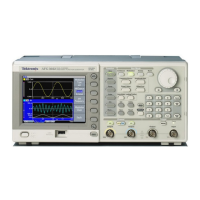Syntax and Commands
3-2 AFG3000 Series Arbitrary/Function Generators Reference Manual
Command and Query
Structure
Commands consist of set commands and query commands (usually simply called
commands and queries). Commands change instrument settings or perform a
specific action. Queries cause the instrument to return data and information about
its status.
Most commands have both a set form and a query form. The query form of the
command is the same as the set form except that it ends with a question mark.
For example, the set command DISPlay:CONTrast has a query form
DISPlay:CONTrast?. Not all commands have both a set and a query form; some
commands are set only and some are query only.
A few commands do both a set and query action. For example, the *CAL? command
runs a self-calibration program on the instrument, then returns the result of the cali-
bration.
A command message is a command or query name, followed by any information
the instrument needs to execute the command or query. Command messages
consist of five element types.
Table 3-2 lists and describes the five different element types.
Table 3-2: Command message elements
Symbol Meaning
<Header> The basic command name. If the header ends with a question mark, the
command is a query. The header may begin with a colon (:) character; if
the command is concatenated with other commands the beginning colon
is required. The beginning colon can never be used with command head-
ers beginning with a star (*).
<Mnemonic> A header subfunction. Some command headers have only one mne-
monic. If a command header has multiple mnemonics, they are always
separated from each other by a colon (:) character.
<Argument> A quantity, quality, restriction, or limit associated with the header. Not all
commands have an argument, while other commands have multiple argu-
ments. Arguments are separated from the header by a <Space>. Argu-
ments are separated from each other by a <Comma>.
<Comma> A single comma between arguments of multiple-argument commands. It
may optionally have white space characters before and after the comma.
<Space> A white space character between command header and argument. It may
optionally consist of multiple white space characters.

